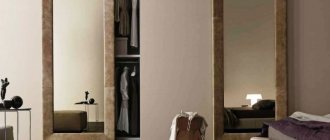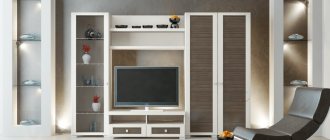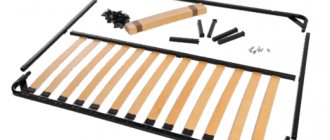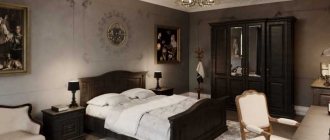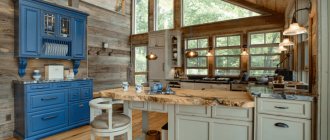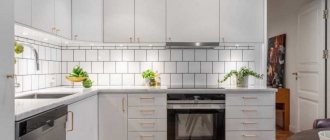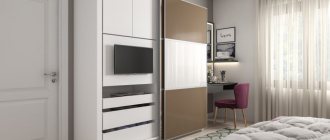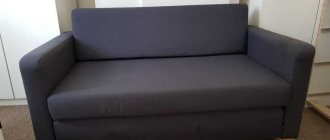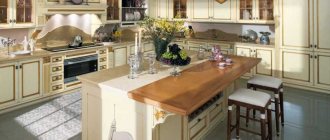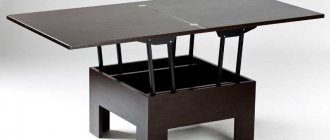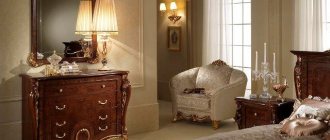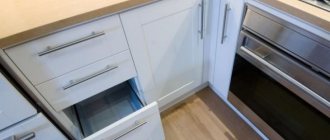Purpose
Drawers, baskets and other structures are used to optimize kitchen space. With the same space taken up, they can fit more things than standard drawers.
Pull-out systems will help organize space in the kitchen
These systems are also designed for additional kitchen equipment. There are many free areas in it where it is impossible to place classic drawers. For example, retractable systems can be placed on the upper edge of the place where the trash can is located. The space itself is not occupied there, but nothing can be removed there either.
By analogy with this place for installing retractable systems in the kitchen, there are many others. As a result, the room does not become visually more crowded, however, there are more functional departments in which you can put something. And this is an additional space saving.
Functional drawers will save space in the kitchen
In addition to the possibility of storage, retractable structures can have their own, separate function. For example, in a large bedside table it is possible to build in a retractable table with chairs for children. Or a cutting board inside the countertop.
Convenient pull-out cutting board
Drawers are the best option for installation in the kitchen. They allow you to make the most of your free space. As a result, with the same occupied volume, they can fit more things than in classic drawers with shelves. And thanks to the external and specific variety of designs, they can be successfully integrated into the interior of any kitchen.
Types of retractable systems for the kitchen
There are a lot of variations of retractable systems for the kitchen. This is due to the number of utensils in which it can be installed. However, they can all be divided into several functional groups, differing in location and application. The most popular of them will be discussed below: horizontal, vertical, corner and original systems. Each type has its own functional characteristics, as well as location.
Horizontal
This type of kitchen retractable systems is one of the most popular. In appearance, such structures are baskets with a large bottom, which are attached to special fittings. And on their facade there is a classic panel with a handle for a drawer.
Horizontal pull-out system for kitchen
Such structures are most often installed in kitchen cabinets instead of standard shelves.
Vertical
Vertical pull-out designs are a rarer occurrence in the kitchen. This is due to the fact that there is no room for them in standard furniture. Therefore, they are installed in unoccupied space.
Options for vertical pull-out systems for the kitchen
For example, on a kitchen table, the legs are not attached to the tabletop at the edges. Accordingly, the space there is free. This location is optimal for installing vertical retractable systems. The fittings are attached to the sides of the table, and the structure is already installed on them.
Attaching a vertical pull-out storage system
This approach allows you to use more kitchen space without adding new elements to the amount of furniture. The ergonomics of vertical retractable systems are very high. After all, they are installed where nothing else can be placed, and do not take up free space.
Vertical retractable systems are highly ergonomic
Corner
A popular type of retractable systems for kitchens are corner ones. The junction of two walls is the most inconvenient place to install furniture. After all, then it’s difficult to get anything out of it. In such situations, such designs are optimal.
They are of the “carousel” type, when, together with the drawer panel, they are pulled out of the wall at an angle. In such a situation, the entire internal space can be filled with kitchen utensils, and after that it will become easier to get them out.
Corner pull-out system for a “carousel” kitchen
Side drawers can be identified as a separate subtype of corner systems. In terms of functionality, they are exactly the same as regular ones. But they differ in appearance. Their front panel is bent at a 90-degree angle in the middle, and the handle is attached to both edges.
Corner storage system with drawers
This type of installation requires reworking the interior walls so that the corner system can move properly. But it will also be very remarkable in appearance, because such a solution can rarely be found in the kitchen at home.
Original
The original types of retractable systems for the kitchen include all those solutions that do not fall under the classification of horizontal, vertical or corner structures.
These are one-piece products of certain sizes. Suitable for installation in a given location. Basically, they perform a function that is not related to storing kitchen items. Most often they are an auxiliary item. A striking example of built-in systems of the original type is a cutting board. It is installed in the table and, if necessary, can be pulled out from there.
Pull-out cutting board built into the table
It cannot be said that some type of retractable systems for the kitchen. They just don't perform exactly the same functions. And they differ according to the installation location. To create a kitchen that will be fully equipped with these structures, you should use several types or all of them. In this case, the room will be as ergonomic and modern as possible.
Pull-out kitchen work surface
About sites that remain unused
There is an area that is not used in any of the functions and remains idle in every kitchen. Usually this place is between the floor surfaces and ovens, under the cooking items.
But even here it is easy to create a space that can be used for storing accessories near the place of main work.
The main thing is to take care of solving the following issues even at the design stage:
- Capacity.
- Separation.
- Height of compartments.
Some difficulties when integrating such elements will arise when working with ready-made types of walls. The retractable corner system for the kitchen will not be an exception to this rule.
Under work tables and stoves, drawers with a shallow depth, 80-120 mm, are placed. Then spoons and forks, various spices will be easy to get at any time you need.
The jars will become stable thanks to special separators. This allows you to clearly delimit the space for each device.
Unusual solutions
Since retractable structures are a modern variation of kitchen furniture additions, some models look quite unusual. In some situations, their functional features stand out. To better understand the specifics of retractable systems for the kitchen, you should consider unusual variations.
Matryoshka box
An interesting solution for the kitchen space would be a nesting doll box. According to the name, one of them will be larger, and the second will be inside the first.
Inside an ordinary drawer in the kitchen, special fittings are installed, onto which the retractable structure will then be attached. Its edges should occupy only the lower part of the free space. And a second drawer will be built into the top one. To install it, you need separate fittings. And it is with its installation that one should begin.
Drawer-matryoshka
As a result, when you pull out the first drawer, access to the second will open. In terms of storage capabilities, such a solution will be inferior to one, but a larger one. However, from a stylistic point of view, this idea is very interesting.
Retractable matryoshka system for the kitchen
Children's table
A pull-out children's table with chairs can be built into a large nightstand in the kitchen. This is an interesting and practical solution.
A tabletop should be placed in the top drawer in the middle of the nightstand. And install a seat in the two lower ones, on both sides of the first. The result is a children's table that can be pushed in, freeing up space for passage.
Pull-out table and chair for the kitchen
Thanks to such a retractable system for the kitchen, it will be possible to save a large amount of space in it. And the supported weight of the fittings ranges from 30 to 50 kg. Therefore, it is absolutely safe for children to sit on pull-out chairs; the structure will support their weight.
This retractable system can support weights up to 50 kg.
Kitchen units with top drawers
Such models are widespread. There are many photos on the Internet or furniture catalogs with different ideas for the arrangement of top drawers for the kitchen. Often it is in one of them that an integral element of the kitchen is located - a dish dryer.
It should be spacious, durable, and consist of several tiers. Other boxes are used for storing food, allocate space for a bread bin, install a microwave oven and carry out an exhaust hood. On top of the cabinet you can put boxes with spare dishes and items that the owners rarely use.
There are different mechanisms for how the cabinet will open. There are also options with and without handles.
A set with several upper modules is an excellent solution for small kitchens or studio apartments.
Advantages of pull-out systems for the kitchen
Pull-out systems for the kitchen have many advantages over classic pull-out designs. You should read them before purchasing.
The main advantage has already been mentioned. Thanks to their placement, it is possible to completely occupy the space of the drawers. In particular, their distant areas, which previously could be reached mainly by touch or by removing the rest of their contents.
The retractable system allows you to reach the farthest corners of the kitchen
Another important advantage, in addition to practicality, will be the appearance of retractable structures. They look stylish and modern. However, they are not immediately noticeable, since they are initially hidden in kitchen utensils.
Pull-out systems for the kitchen look modern and stylish
It is also worth highlighting their versatility. Pull-out systems for the kitchen exist in many variations, differing in shape and size. Thanks to this circumstance, they can be easily integrated into most suitable furniture.
The retractable system can be designed to suit any kitchen style
Thanks to retractable structures, it is possible to additionally equip kitchen utensils. Additionally, take up free space, without compromising the ergonomics of the solution and the convenience of the home owners. For example, build it into the door of a trash can drawer.
Garbage bin built into the drawer door
The use of retractable systems for the kitchen allows you to optimally occupy its free space. And such solutions will look stylish. In most cases, these structures will last a long time.
Washing area and use of pull-out structures
And in this case, you can choose special containers whose appearance will please you. Even if they are intended to store garbage and household chemicals.
Designs equipped with electric drives make operation simpler and more convenient. Access to the contents inside opens after one light pressure with your knee.
Cleaning accessories are easily hidden from prying eyes by a drawer that is used to equip the sink.
Flaws
However, such designs also have disadvantages. There are not very many of them and they do not overshadow the advantages. However, you should familiarize yourself with the negative factors of systems for organizing free space in the kitchen. Thanks to this approach, you will be able to prepare for them in advance, avoiding possible inconveniences.
Cost of systems. The price for retractable structures can rather be attributed to disadvantages. Mesh baskets, as well as other variations, will be more expensive than classic kitchen solutions.
Additional installation required. Before installing pull-out systems for the kitchen, you should prepare areas for their placement. Special fittings are installed inside the drawers, and the structures are fixed to them.
Pull-out kitchen systems require additional installation
Dependence on the tools and skills of the master. This drawback follows from the second. To install these structures, you need a number of tools, as well as a special person who can competently carry it out.
Care. To ensure that the fittings do not become loose and prevent the structures from tilting, it is necessary to monitor them. If you do not tighten it in time, the load on the retractable structures will increase. As a result, this can lead to its breakdown, including irreparable damage.
In addition to the above disadvantages, there are several more, but already related to the type of fittings installed in retractable kitchen systems. The more expensive it is, the fewer disadvantages it has. But the high price itself also becomes a disadvantage.
Thus, the disadvantages of retractable structures themselves are not so significant and most often are of a local nature. But a number of advantages offset them. Therefore, installing systems for organizing free space for the kitchen will bring much more benefits. And there will be less inconvenience than with classic solutions.
A retractable kitchen system is much more convenient than a classic storage system
The advantages of retractable kitchen systems far outweigh the disadvantages. And even those are mainly associated not with inconvenience, but with price and installation. High-quality fittings will last for many years and will ensure full opening of the drawers, without unnecessary noise. By choosing retractable designs, home owners make using the kitchen much more comfortable.
Selection of ball guides
To choose the right furniture guides, you need to consider:
- types of device;
- technical characteristics of guides;
- manufacturer, on which the quality of furniture fittings depends.
Types of ball guides
Ball-type guides can be classified according to several criteria:
degree of opening. Partial and full extension systems are available. With limited movement, the viewing angle of the contents is reduced and approximately the distant 5–6 cm of the box is not visible. The full extension system allows you to view the entire contents of the drawer;
Differences in guides according to the degree of opening of drawers
- maintainability. There are cheaper one-piece guides, which in case of breakdown can only be replaced, and detachable structures that are subject to repair, and within the same manufacturer, the interchangeability of component parts;
- installation method. There are standard guides, which are mounted on the side walls of the drawer, and hidden-mounted guides. With this method, the drawer system is installed from the bottom of the drawer, which allows you to hide all the elements and increase the internal space of the cabinet, chest of drawers, cabinets, and so on.
Concealed ball guides
- number of steps. There are single-level and multi-level guides. Depending on this indicator, the maximum load on the box is determined;
- the presence of additional elements. The guides can be equipped with closers that allow the drawer to be closed smoothly, which increases the service life of the furniture and/or with a Push-to-open system - opening the drawer by pressing the front part of the facade.
Push-to-open system principle
What are the best guides? Each user must decide independently, based on the type of furniture (wardrobe, cabinet, chest of drawers, etc.) and the surrounding space.
Selection of technical parameters
After determining the type of guide, you need to select the correct dimensions. Allowed:
- reducing the length of the retractable system relative to the length of the drawer by 10 - 15 mm, but not more than 75% of the indicator (calculation according to the manufacturer’s recommendation). For example, for a drawer 400 mm long, guides 300 - 400 mm long are suitable;
- The width of the guide system is determined according to the required load.
Main dimensions of ball-type guides
Popular manufacturers and their features
The most popular company engaged in the manufacture of various types of retractable systems, including ball guides, is the Austrian company Blum. The main advantages of the manufacturer are:
- use of high quality materials;
- production control at all stages;
- checking accessories before sale;
- application of diagrams for self-installation;
- long service life (manufacturer’s warranty – 15 years).
Among the disadvantages, one can note the high cost of guides and other types of retractable systems.
Furniture fittings from the Austrian company Blum
To reduce the cost of purchasing accessories, you can pay attention to the following companies:
- German company Hettich. The quality of the manufactured accessories is not inferior to the generally recognized leader, but the cost is significantly lower;
- the Polish company GTV, which produces large-sized fittings;
- the Polish company Fgv, whose main specialization is the manufacture of various types of guides and furniture hinges;
- Russian companies Boyard and Firmax. The price of fittings from domestic manufacturers is the lowest, and the quality is at a high level.
Types of accessories
In addition to appearance and location, retractable structures differ in installation method. The boxes in which they are fixed are pre-equipped with special fittings. And the reliability and functionality of the entire structure will depend on it.
Roller guides
At the moment, the mechanism for fitting roller guides is the simplest. One such guide is attached to the drawer, and the second is attached to the drawer system. During installation, they are combined, thereby creating a movable structure.
Drawer with roller guides
Roller guides are the most unreliable option. Some of their elements are made of plastic, for this reason they can withstand a load of up to 25 kg together with the box. The roller guides also make a distinct sound when extending or closing. They are not aggressive, but such a system will not be silent. Another disadvantage is the fact that after installation they cannot be further adjusted. This hardware does not include any additional functionality.
However, their prevalence is due to a number of advantages. In terms of cost, roller guides are very cheap. This fact is due to the simplicity of the design and the absence of additional elements. In addition, it is worth highlighting the fact that the roller guides can be mounted in any place, as long as there is enough free space in it.
Roller Guide Kit
Roller guides are suitable for fastening lightweight elements of kitchen drawer systems. So that the total load on them does not exceed the permissible weight. In such cases, the structure will last for several years, but you should not count on it for a long time.
Ball guides
Ball guides are a more advanced version of the fittings. They have a telescopic opening type. That is, as the structure expands, it increases in length, and when closed, it decreases. Thanks to this solution, the fittings system is seamless. One end of it is fixed to the pull-out basket, and the other to the inside of the drawer.
Drawer with ball guides
Ball guides provide greater extension of the structure. And the weight they can withstand reaches 30 kg. And they make less sounds.
Ball guides
However, this type of fittings costs more than roller fittings. Therefore, the price of a kitchen pullout system with ball guides will be higher. But this design will also last longer.
Metabox fittings
Metabox fittings are the walls of retractable baskets with mechanical elements. The side edges are made of metal.
Metabox system for retractable system
The design itself has the possibility of three-dimensional adjustment. Metabox fittings can withstand loads of up to 30 kg. The movement when moving is smooth and silent. The drawers can be extended either to their full length or partially.
Drawers with metabox fittings slide out smoothly and silently
Their price is reasonable, a little more expensive than ball guides. However, the reliability indicators of such systems are higher.
Cargo systems
Retractable systems of certain dimensions and shapes are produced, which are attached directly to the furniture in the kitchen. They are called cargo systems. That is, these are ready-made structures with fittings. The movable mechanisms in them are placed directly on the elements of the drawers.
Example of a built-in kitchen cargo system
One of the advantages of such systems is ease of installation. After all, the fittings are already located on them; it is enough to prepare the kitchen furniture for installation. Reliability should also be highlighted. Monolithic structures will last a long time and can also withstand heavy loads.
The cargo system has a long service life
The main disadvantage of retractable cargo systems is their cost. A prefabricated structure of this type will be much more expensive than pull-out systems for the kitchen with fittings that are installed separately.
Selection of retractable systems for the kitchen
You should choose retractable structures for the kitchen only after familiarizing yourself with their types and variations of fittings, as well as their advantages and disadvantages.
First of all, you should focus on appearance. Retractable systems should fit well into the interior of the kitchen. It is desirable that their colors either match or be combined with the style of the rest of the furniture.
The retractable system should be in harmony with the overall style of the kitchen
Don’t forget about the fittings of these structures. It is necessary that it can withstand the entire load. Roller guides in this regard are the most impractical due to their low reliability. However, the price of drawers with such fittings will be budget-friendly.
The most expensive solution is the cargo system. After all, this is a solid structure that is built into furniture. It features increased reliability and high functionality.
The cargo system is highly reliable
Designs with ball guides and metabox fittings are intermediate options. They are quite reliable and can withstand a load of up to 30 kg, which is quite enough for kitchen conditions. They have a silent move, and also have the ability to customize the fittings. In terms of price, such solutions will be more expensive than roller guides, but cheaper than solid cargo systems.
The dimensions of retractable kitchen systems are also important. They must completely occupy the niche intended for them. If the structure is larger, it simply will not fit into the corresponding box, and it is not possible to shorten it.
With smaller dimensions everything is simpler. In this case, the drawer system will not be able to be secured on both sides of the drawer if it is built into it. The load on the structure will increase, which will negatively affect its lifespan. As a result, it will become beyond repair.
But the internal structure of the box can be rearranged so that the pull-out structure is securely attached. But this will take a certain amount of time and also require materials, tools and appropriate skills.
However, with dimensions everything is simpler, because retractable systems for the kitchen are most often made in classic sizes, which include standard drawers. Therefore, the main emphasis should be on appearance, purchase budget, fittings and reliability. But also take into account the dimensions. With this approach to selection, you will be able to choose the best option for the kitchen.
Calculation of drawers
To avoid confusion and misunderstanding, let’s define the initial data:
The furniture is made of laminated chipboard with a thickness of 16 mm; fibreboard with a thickness of 4 mm is used for the bottom.
- Width of the cabinet/cabinet (external dimensions) = X.
- The height of the niche for installing drawers in the cabinet/cabinet (minus the overhead countertop) = Y.
- Depth of the cabinet/cabinet stand (sidewall) = Z.
Calculation of the drawer front
Whatever one may say, the calculation of the inside of the box largely depends on the front part.
The facade can be internal (rolled over the side walls of the body) or overhead.
As you can see from the drawing, the choice of overlay or internal front can affect the depth of the drawer. In the case of an inset one, it is rolled deeper to the thickness of the facade (-20 mm from the depth of the stand).
The height of the drawer front usually varies between 150-200 mm. It all depends on what will be stored inside. For documents and stationery in office cabinets, smaller drawers are made, 120-150 mm deep, rarely 180 mm. The linen drawers of the chest of drawers are designed deeper, ranging from 180 mm to 250 mm. For toys and bedding, drawers can be even deeper along the height of the facade, but in this case it is necessary to reinforce the bottom with a stiffener or partitions.
The size of the drawer fronts, taking into account the technological gap, is calculated by analogy with other doors; you can read more in detail here. In short, 2-3 mm is subtracted from the dimensions along the outer perimeter; the gap between adjacent facades is also 2-3 mm.
An example of how to calculate the fronts for two drawers relative to our cabinet with dimensions X*Y*Z.
- Internal facade: (X-16*2-3)x((Y-16*2)/2-3)
- Overlay facade: (X-3)x(Y/2-3)
The height and length of the facade can be swapped if there is a texture and the desired direction of the pattern - longitudinal or transverse. When edging PVC facades around the perimeter, it is necessary to take into account the thickness of the edge!
How to calculate the side of a box
Drawer guides are available in 50 pitches, ranging from 250 mm to 550/600 mm. Hardware manufacturers always have a similar layout in their catalogs, which can help you navigate the dimensions and markings for fasteners.
dimensions of roller guidesdimensions of ball guides
Thus, the depth of the sides of the drawers is taken in increments of 50. For the shallowest drawers, 250 mm, and further, correlating the depth of the standing cabinet/cabinet with the length of the suitable guide - 300, 350, 400 mm, etc.
The narrowest side of the cabinet/cabinet for built-in is 260 mm for the overlay facade and 280 mm for the internal facade (for a 250 mm guide). The required clearance at the front edge for installation is usually 2 mm. The gap at the back is arbitrary, from 1-2 cm to 5 cm. If there is more left, it is better to purchase longer guides so as not to waste space behind the drawer. It turns out:
(drawer depth) = length of the guide and less than Z by no more than 50 mm.
How to calculate the front (front and back) of a drawer
If we again turn to the manufacturers' catalogs, we can see that the gap between the sides of the cabinet/cabinet body and drawers is about 12.5-12.7 mm.
In fact, when calculating, these numbers are rounded by subtracting 13 mm. This makes the drawer move more freely and is easier to adjust.
In the drawing, the calculation diagram for the box is clear and understandable. Thus, to calculate the “forehead” of a drawer, you need to subtract the thickness of the chipboard from the dimensions of the cabinet/cabinet 4 times (2 on each side) and a gap of 13 mm, also on both sides. 16*4+13*2=90. It turns out:
(forehead length)=X-90mm.
How to calculate the depth of a drawer
There are no special standards regarding depth. Usually 10-20 mm are left under the facade (Z5), and 30-80 mm above the facade.
Thus, if, for example, the height of the facade is 150 mm, then the depth of the drawer will be about 80-100 mm. I base my calculations on the cut cards. If reducing the depth of the drawers allows you to more compactly place the parts on a sheet of chipboard, then this is worth taking advantage of. There are situations when several parts fit onto a new sheet, but if you “play” with such unprincipled dimensions of the parts, you can save on buying a whole sheet with a huge remainder!
Fiberboard bottom calculation
There are two ways to install the fiberboard bottom - overlapping and in a groove. In the first case, the bottom is nailed to the drawer frame from the back side. In the second, it slides into a special groove.
- When fastening with an overlap, a gap of 2 mm is taken away. That is ((length of forehead)+16*2-2)x((depth of drawer)-2).
- When the groove depth is A, mm on each side is added to the internal dimension (A-2) mm on each side. That is ((length of forehead)+ (A-2)*2)x((depth of drawer)-16*2+(A-2)*2).
